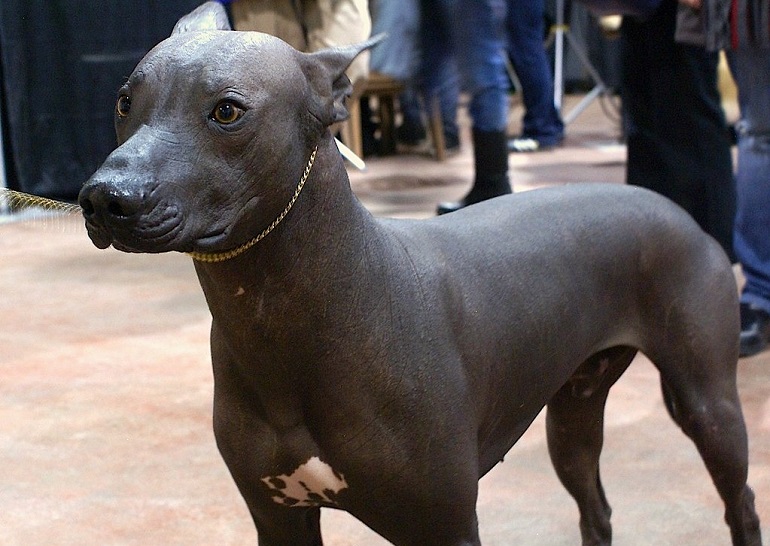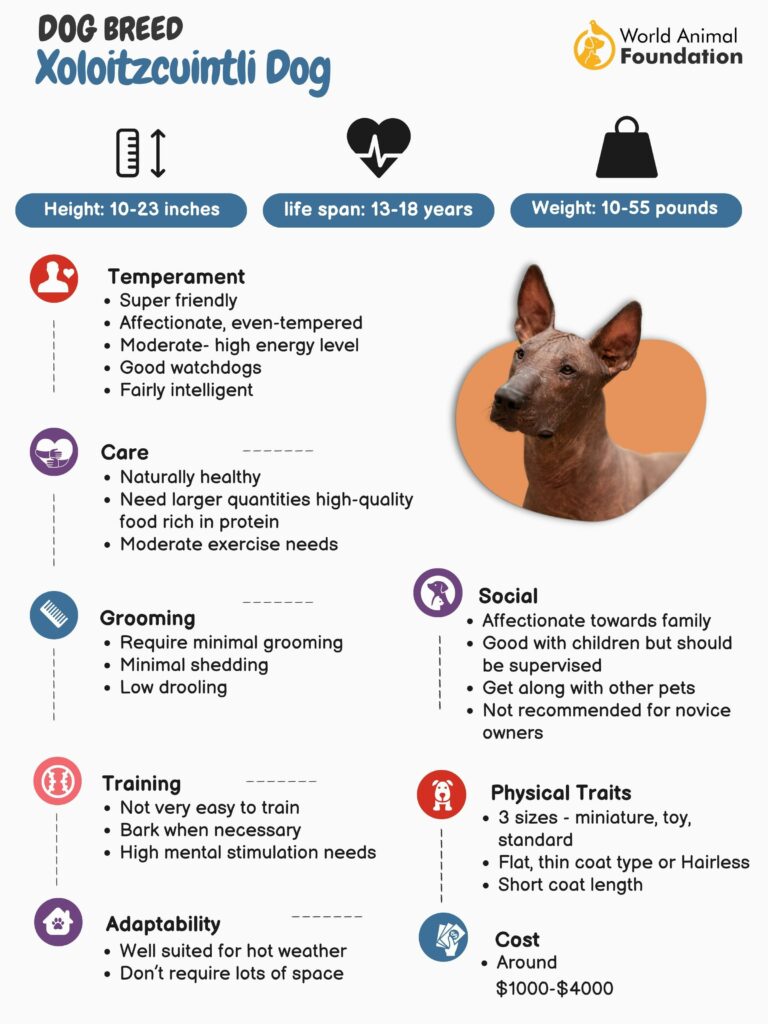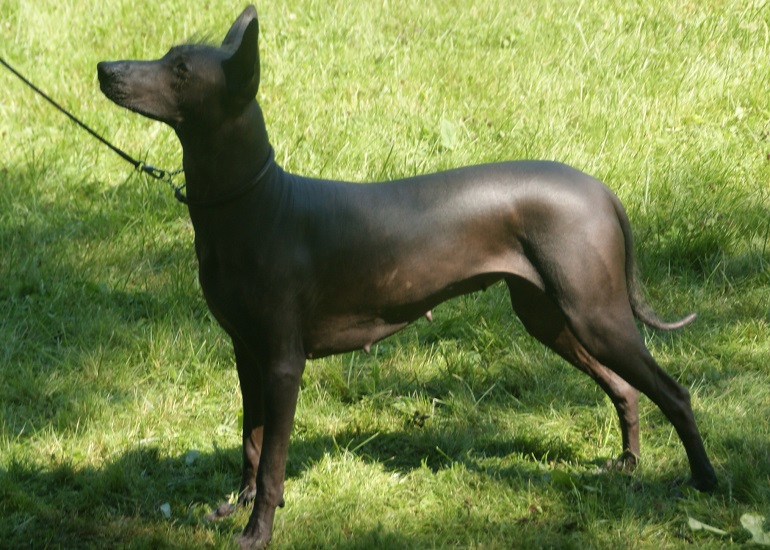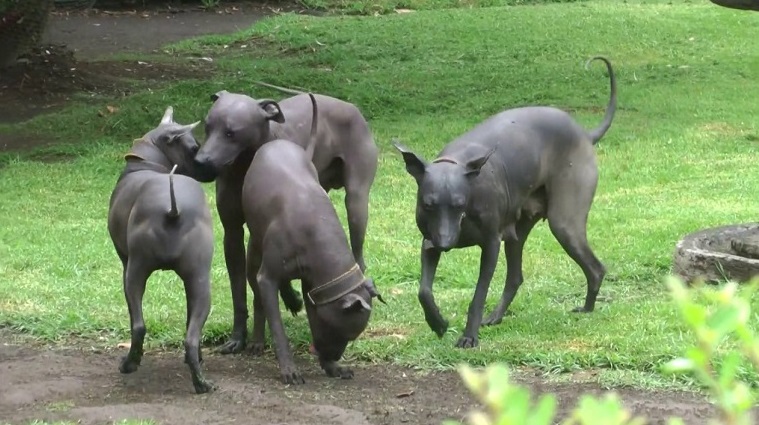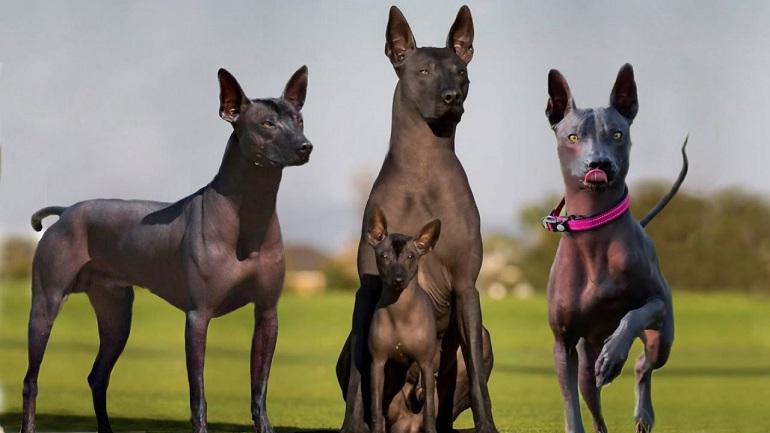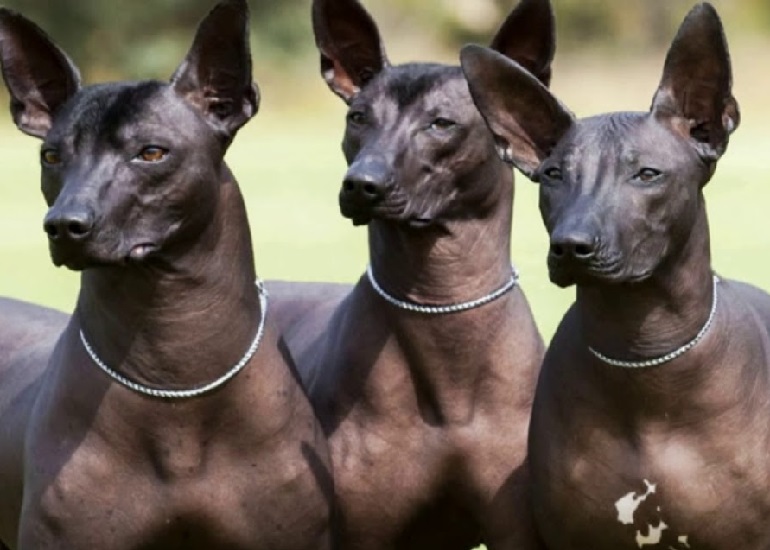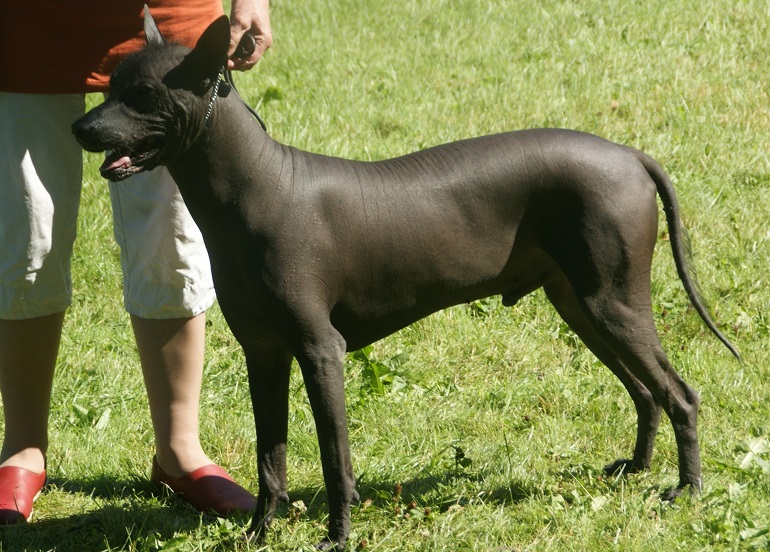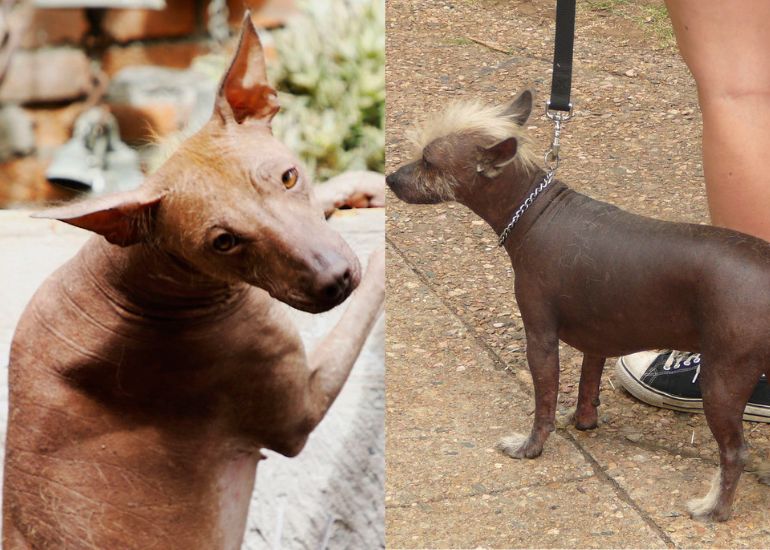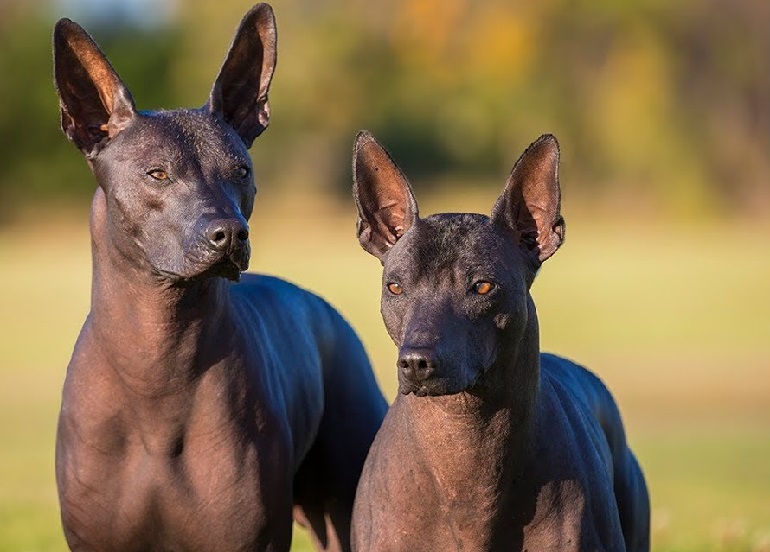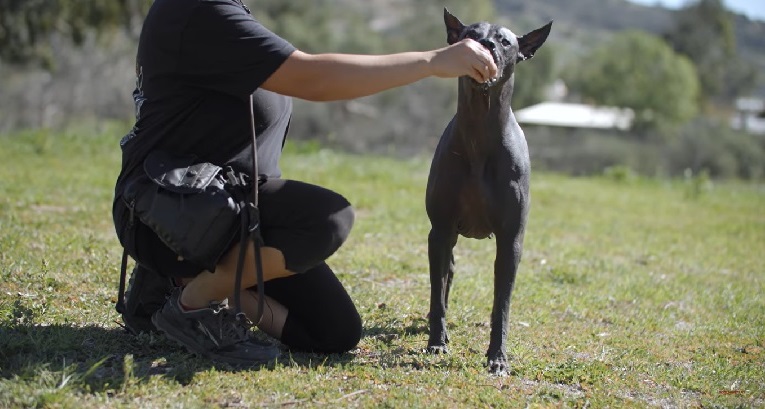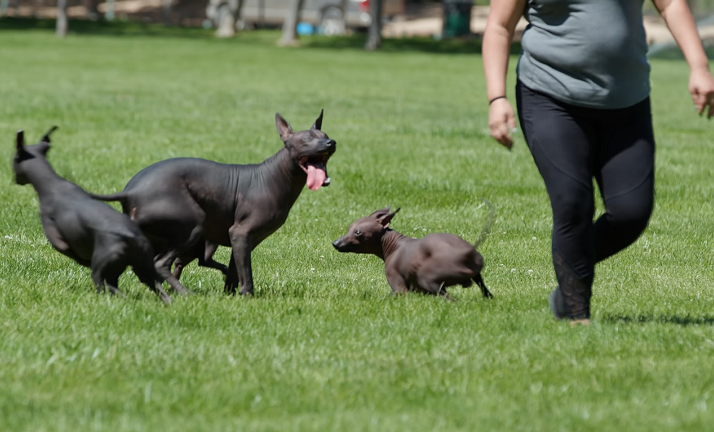The Xoloitzcuintli, often simply called the Xolo, is a remarkable breed steeped in rich history and cultural significance. Revered by the ancient Aztecs and sometimes referred to as the Mexican Hairless Dog, this unique breed is known for its striking appearance and loyal temperament. With roots tracing back over 3,000 years, Xolos have been treasured as companions, guardians, and even spiritual guides. Beyond their intriguing heritage, Xolos are celebrated for their intelligence, agility, and hypoallergenic qualities, making them an attractive choice for modern dog enthusiasts. Discover the fascinating journey of this ancient breed and the unique characteristics that define it today.
Remember the dog, Dante, from the famous Disney movie Coco? Well, that’s none other than Xoloitzcuintli. With their distinct hairless body, long erected ears, and regal body frame, Xolo dogs can be easily identified among multiple dog breeds.
However, their closest relation with prehistoric dog breeds makes these hairless dogs superior to other Mexican canines. In fact, they got their name, Xoloitzcuintli, from two ancient Aztec words: Xoloti means the God of death and lightning, and itzcuintli means the dog.
The best part is that despite possessing such a rich history and unusual appearance, Xolo dogs are becoming quite popular among dog owners and celebrities.
So today, we are going to discuss Xoloitzcuintli dog breed information, interesting facts about dogs, body structure & temperament, historical background, and many other aspects in detail.
Keep reading to know the reason behind the hype of this Mexican hairless dog breed. Shall we begin?
About the Breed
Xoloitzcuintli is known as the Aztec dog of Gods, and it has its roots deeply penetrated in the ancient Maya and Aztec civilizations. The current body structure of Xolo dogs consists of a large, athletic structure with rugged skins & slender waists and lean heads.
They are both affectionate and serious, depending on the situation. For instance, when being around their owners, these dogs can be the most lovable. They bond quickly with family members and crave attention and cuddles, setting the bar for other pets way too high.
On the other hand, when performing the duties of watchdogs, Xolo can stay super focused and alert. Not any activity or object can distract these Mexican hairless canines. However, the best part is that these dogs don’t have the habits of excessive barking.
They bark only when they want to alert the owner and stay completely quiet for the rest of the time – Not even rolling! Speaking of their general appearance, Xoloitzcuintli dogs are divided into two categories; hairless Xolos and coated Xolos.
Hairless dogs feature smooth, tough, and close-fitting skin, whereas the coated variety contains tough skin with a short, straight, and flat coat. Both the puppies and adult dogs of this breed have serious faces with thoughtful expressions.
Xolo dogs, both the coated and hairless variety, come in three different sizes: miniature, toy, and standard. Whereas this dog breed comes only in dark shades (both the hairless and coated ones). The most popular shades are grey, slate gray, gray-black, bronze, red, and liver.
Although Xolo dogs are considered the perfect choice for house pets (especially for warm climates), this primitive breed was mainly bred for hunting and warming purposes.
History of the Xoloitzcuintli
As stated before, Xolo dogs have their roots dating back to 4000 years ago, and they seem to originate from the Maya and Aztec empires. The name, Xoloitzcuintli, is believed to be named after the Mayan god, Xolotl.
Mayan people used to believe that Xolotl was the god of the underworld, which led human souls from this world to the world outside. According to ancient mythology, Xolotl created this dog breed to introduce the mortal realms to this world and its humans.
Considering this theory, Mexicans still believe that being cruel or harsh with Xolos will lead you to huge trouble since the dog won’t help you cross the bridge between heaven and the world. Due to this, Aztecs used to sacrifice and bury these dogs with their deceased owner as his protective guide.
In addition to this, people used to associate miraculous healing powers with Xolo dogs. According to their beliefs, Xolos, due to being a warm-bodied canine, can heal all health issues, from a general toothache to terrifying insomnia., asthma, and arthritis.
In the sixteenth century, Christopher Columbus mentioned the same breed, using the phrase strange hairless dogs to refer to Xolos. Due to the very same reason, Xolos are considered the very first dog of the United States.
Besides enjoying a prophet status, Xolo dogs were also used for hunting and to fight off starvation during times of food shortage. After turkey, ancient humans used to feed on this hairless dog since it comes with a high protein content.
You might be surprised to know, but apart from being used in early socialization, this dog was a normal domestic pet that can be found in all households.
It might sound too odd, but if you belonged to Mexico, chances are high that your ancestors used to consume Xoloitzcuintli canines regularly.
Various Spanish conquistadors also wrote about this breed, reporting their closeness with locals and how politely people treat them (they even let their pets sleep with their children in the same blankets.
However, the concept of consuming a dog was super absurd near Spanish invaders; they soon overcame this repulsion and fell in love with its taste. Due to the overconsumption and arbitrary crosses with different breeds, Xolos became nearly extinct and still are considered the rarest dog breed in America.
At the beginning of the eighteenth century, the total number of living Xolo dogs was so low that the American kennel club eliminated them from their breed club.
Thankfully, the American Kennel Club made some efforts to revive this endangered breed, due to which Xolos made a comeback.
In addition to the kennel revival program, some prominent Mexican artists, like Diego Rivera, Frida Kahlo, etc., began taking more interest in their national dog breed; Xoloitzcuintli, and made them a significant part of their masterpieces.
This, in turn, increases further awareness among locals about the preservation of Xolos. Finally, in 1950, a team of scientists worked on a proper project regarding the Xolos revival.
For this, the team visited the Mexican villages where the true Xolo breeds still existed, sourced them out, and let them breed with each other to increase their numbers.
Xoloitzcuintli Facts
Not the Best Choice as Guard Dogs
Yes, we mentioned before that the Xolo dogs are excellent watchdogs, but you can’t have a Xolo to guard your premises.
With their loud barks and alertness, they can alert you about all the intruders (humans and evil spirits), but since they are mostly shy and reserved towards strangers, they can’t fight the invaders off.
Perfect Pet Option for Allergic People
If you are allergic to canines or other furry animals, you should give Xolos a chance. Since one of their varieties is completely bald, it discards the chances of fur allergies.
Besides, if anyone in your family has asthma, Xolos will make a safer pet alternative than other animals – Just make sure you are not getting a coated Xolo.
Best to Add to Your Pet Pack
Xoloitzcuintli is super lovable, which makes them one of the best family dogs. However, the more impressive fact about Xolos is that they interact with the whole family, including humans and other dogs or whatever pets you already have.
Even if you adopt a pet after adopting Xolo, they won’t feel envious or aggressive towards the newcomer. Instead, it will bond amazingly with him, just within a few days. If given enough freedom, your Xolo may even socialize with your neighbor’s cat, too.
Naturally Healthy Dogs
Due to spending a huge time in ancient villages and jungles, this ancient breed possesses a natural resilience against rough environmental conditions. Considering the natural protections and health strengths they have, you don’t need to pay too much attention to their living conditions.
The best part is that the Xolos don’t require way too much exercise, and neither do they develop fence aggression easily. It means you can keep your Xolo in a fenced yard without compromising his emotional and mental stimulation.
Still, to make sure that you are getting the healthiest Xolo puppy without any severe health problems, get your pooch from responsible breeders.
Xolo Is the Purest Dog Breed
Xolo is one of those few dog breeds that originated as a result of natural selection. Also, the breed didn’t include any human manipulation, which makes it the purest dog breed existing today.
This natural origin is another reason why Xoloitzcuintli dogs are super healthy, rugged, and intelligent.
Rarest Dog Breed
As stated before, the number of Xolo dogs decreased massively due to overconsumption and brutal slaughtering by Mayan and Aztec people. Although their number was increased successfully with the continuous efforts of the breed club, they are still the rarest canine breed out there.
According to an estimate, the entire world contains a total of 30,000 Xolos, whereas America contains only one thousand Xolos.
Looks Cute in Their Unique Way
Mostly, the hairless canines don’t look as cute as golden retrievers or other fur-rich dog breeds; Xolos, despite having a tight-fitting coat, looks cute in a unique way. They have almond-shaped eyes, erect ears, and amusing expressions, which makes them strangely adorable.
Xoloitzcuintli’s Appearance
Although we have penned down the key features of Xolos before, let’s have a closer look at their appearance;
Size
Based on the size, Xolos are categorized into three major categories; miniature, toy, and standard. The smallest one is the toy dog, with a size of about 10-14 inches.
On the other hand, miniature dogs are 14-18 inches tall, whereas the standard Xolos can be 18-23 inches tall (as tall as a Belgian sheepdog, Bernese mountain dog, and German shepherd.
Another interesting thing about this unusual dog breed is that its female can be slightly longer than the male. Also, all of these three-size varieties can compete as an entity in the AKC competition to become the ultimate AKC champion.
Weight
Based on their size, the weight of Xolo dogs may vary. For example, the toy Xolos may weigh around 10-15 pounds, whereas the miniature Xolos may weigh around 15-30 pounds.
Since standard Xolos are the largest, they could be as heavy as 35-55 pounds. Problems related to weight gain may arise due to the lack of exercise or irregular food consumption.
Coat
Although Xolos are divided into two main classes based on coat types, hairless and coated dogs, hairless Xolo is not completely bald. The standard Xoloitzcuintli may have trails of fur on the tail, head, and feet.
On the other hand, the coated variety has thin, smooth, and close-fitting fur covering the whole body. Some breeders sell Xolo puppies with long, too-thick, and plush hair, but experts don’t consider such puppies as true breed Xolos.
Color
Both the coated and hairless Xolo dogs exist in a wide range of colors (mostly dark shades). However, some pet seller also offers Xolo with different color combinations, like a combo of black and white or brown and black.
Remember that it doesn’t matter how appealing the color combo looks, breeders don’t consider such Xolo dogs desirable, and their favorites are only the Xolos with a solid color.
Besides coat color, Xolos also features super unique eye colors, from pitch black to dark brown to caramel.
Xoloitzcuintli Temperament and Personality
Xoloitzcuintli canines have a super friendly and socialized temperament, and they are always ready for cuddles. They can bond with all the family members but may get attached to one member specifically (the one who takes care of it the most).
Despite having a rough and tough demeanor & serious expressions, they are quite gentle with children and other four-legged members of your family. Some say that nothing can make a Xolo dog happier than cuddles and dog hugs.
Due to their wild needs for physical and emotional connection, they may develop separation anxiety way too quickly if you won’t give them enough attention due to your tight schedule or a 9-5 job routine.
As a result of this separation anxiety, they may show destructive behavior problems. Therefore, it’s advised to either drop your Xolo at a pet care center or at your neighbor’s so your doggie won’t feel alone or left out.
However, you should not make it a routine to leave your younger dogs at dog daycare since they will get extremely angry at you and throw tantrums like a teenager. Last but not least, Xolos, despite being quite social, doesn’t mix with strangers quickly.
If you host some guests (some new faces) at your home, your dog won’t jump into their laps instantly. Instead, he’ll take his time to decide whether he wants to grow friendly with them or not.
Another reason for this reserved behavior towards new people and animals is their high prey drive. Although it has been thousands of centuries, their hunting instincts are still way too strong and, sometimes, may dominate their friendly side.
That’s why it’s important to train your dog to suppress its hunting instincts. However, you also need to remember that Xolos have quite sensitive souls.
So, avoid being too harsh on them while training; otherwise, it might destroy their mental health, making them scared and distrustful of you.
Xoloitzcuintli Health and Care
We have read why Xolo dogs are called naturally healthy canines. If given moderate exercise and high-quality dog food, their life expectancy can be 13-18 years.
However, due to having less dense or nearly negligible fur, several skin problems arise from them, such as sunburn. Although Xolos are warm-bodied animals, they can’t tolerate scorching sun rays.
On being exposed to sunlight for long hours, Xolos may develop intense sunburns – Especially if your Xoloitzcuintli canine has a light-colored coat. Besides, some Xolos also come with missing teeth.
However, it’s more a genetic trait than a health ailment since the gene that is responsible for hairlessness is also responsible for teeth loss too.
Speaking of health disorders to which a Xolo may get subjected to are patella luxation, hip dysplasia, arthritis, knee, heart, and eye conditions.
Most of these ailments arise due to poor breeding conditions and improper screening. Therefore, you better go through all the essential health certificates before committing to a Xolo pup.
Speaking of care, the coated Xolo canines need regular brushing and minimal grooming to look tied up. Whereas these hairy canines don’t need to take baths as frequently as hairless Xolo requires.
The hairless breed needs much more care and bathing since their skin is rough and rigged, and possesses numerous stripping natural protections. When such a canine turns one year old, this natural protection begins to strip off, causing breakouts and clogging pores.
So, during this period, you need to take extra care of your Xolo friend. Make your four-legged friend undergo more bathing sessions (but avoid over-bathing). After every bath, apply a mild, pet-friendly sunscreen after the consultation with a certified vet.
To avoid hip, knee, and joint issues, keep an eye on your dog’s intake to avoid overconsumption. Remember that most structural disorders arise due to being overweight. Therefore, to ensure your pooch’s best health conditions, discuss his feeding routine and requirements with the Xoloitzcuintli breeder and vet thoroughly and follow the prescribed diet plan.
Wondering about the exercise requirements? Luckily, these canines don’t need way too many strenuous activities since daily walks and small playing sessions will be sufficient to keep your dog fit and healthy.
Xoloitzcuintli Training
As mentioned before, Xoloitzcuintli canines have sensitive souls that can’t sustain even a minor act of punishment. While training them, you are recommended to use only verbal commands and reward tricks.
If you spank or yell even over your adult dog, it will be drastic for your pup. Luckily, young Xolos are super smart and quick learners. If trained properly, they can pass obedience training and housetrain quite easily.
Another thing that you should keep in mind is that the Xolos can be quite creative escape artists. That’s why, you should create a definite boundary around your yard so they won’t run away, due to their independent thinking and high energy.
Speaking of establishing safe perimeters for these energetic, yet sensitive pups, exploring the Halo collar reviews and SpotOn fence reviews could provide you with efficient and humane solutions. Both these innovative collars offer smart, gentle, and ethical approaches to creating virtual boundaries that protect your Xolo without the harshness of physical barriers or traditional shock collars.
Xolo puppy could be just like a child, and it starts developing habits (both good and bad ones) from quite a young age. Therefore, you better start your pet’s training from the very first day – regardless of your dog’s age.
Conclusion
Due to being super smart, focused, loving, and shed-proof, Xoloitzcuintli dogs undoubtedly make the ideal pet choice for all the canine lovers out there.
If you are planning to purchase a Xolo pup, it might cost you $2000-$40000. However, from the rescue centers, you can adopt an adult Xolo without paying a hefty amount.
Whether you are a homie or an adventurer, these canines can be your perfect companions, providing you with both unconditional love & protection.
Not only this, Xolos can act as your portable hot water bottles by giving off the warmth of their bodies, preventing you from catching a cold or hypothermia.
The Xoloitzcuintli, often called the Mexican Hairless Dog, is a remarkable breed with a rich history dating back over 3,000 years. Revered by ancient civilizations like the Aztecs, they were considered sacred and believed to have healing powers. Known for their distinct lack of hair, they require minimal grooming and are hypoallergenic, making them ideal for allergy sufferers. The Xolo comes in three sizes—toy, miniature, and standard—and can also be found in a coated variety. Intelligent and loyal, they make excellent companions. Their unique heritage and striking appearance continue to fascinate dog lovers worldwide.

